(Note: This is part 1 of a 3-part story on Lucky Craft hardbaits. Part 1 covers crankbaits, including 7 lipped and 5 lipless cranks. Part 2 presents 6 of Lucky Craft's best jerkbaits. Part 3 floats 4 of the finest topwater options. Those are my 22 lucky-est choices among Lucky Craft USA's 75 bass models. I hope you'll find a bait or tip or two here that may be lucky for you too!)
Lucky Craft Moonsault CB Series
Way back when Lucky Craft was first getting into the North American market, the Moonsault CB series were the first crankbaits introduced here by Lucky Craft. Originally designed for the Japanese angler's style of fishing, the Moonsault CB's are characterized by having hooks on the small side with sensitive balances. By sensitive, I mean they work very well on a slow retrieve, but on moderate to fast retrieves, may tend to become unbalanced and act flippant.
Reason is, Japanese anglers tend to use lighter tackle, smaller hooks and appreciate more fine-tuned balance in lures versus North American anglers who use heavier tackle, prefer larger hooks and desire more lure stability than our Japanese counterparts.
Nevertheless, two Moonsault models, the CB-200 and CB-350, have proven themselves admirably in the USA. They've pretty much always been the two most popular Moonsault models here, recognizing they have finer balances requiring lighter hooks and a relatively lighter tackle approach to cranking.
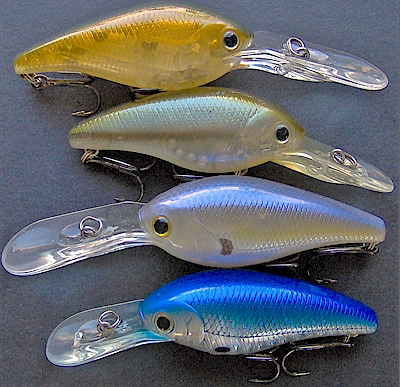
Top down: CB-350's 1st & 3rd. CB-200's 2nd & 4th.
Lucky Craft Moonsault CB-200 ~ Medium-Running Crankbait
Model: Moonsault CB-200
Type: Floating/Diving Crankbait
Weight: 7/16 oz (12.2g)
Length: 2-1/4" (60mm) excluding lip
Factory Hooks: Two #6 VMC Black Nickel
Depth: Approx. 6 feet
The CB-200 is one of the first few baits that Lucky Craft introduced to the USA way back when, and it still continues to be popular with many anglers today.
The CB-200 is a good medium-running crankbait that has withstood the test of time.
The medium-running depth of the CB-200 is well-suited to the needs of a large group of anglers, including (but not limited to) shore anglers or those who fish typically smaller waters.
It's well worth trying the CB-200 if you have not already.
Lucky Craft Moonsault CB-350 ~ Deep-Diving Crankbait
Model: Moonsault CB-350
Type: Slow-Rising, Deep-Diving Crankbait
Weight: 1/2 oz (14.6g)
Length: 2-1/2" (62mm) excluding lip
Factory Hooks: Two #6 VMC Black Nickel
Depth: Approx. 8-10 feet
If you use deep-diving cranks, then you need to try the venerable CB-350. It's a time-proven winner.
The CB-350 is a deep-diving crankbait that has withstood the test of time. The CB-350 is one of the first few that Lucky Craft USA introduced here, and it still continues to be popular with many anglers today.
Only one other Moonsault model (the CB-200 medium-runner) is as popular as the CB-350.
The CB-350 combines all the best features of fat-bodied crankbaits, rattling vibration baits, and suspending jerkbaits into one lure. It has the long bill, fat body, and deep-diving qualities of a crankbait. Internal weights shift position so it casts far and dives quickly, seeking bottom fast. Inside, it has seven separate rattling chambers and a center wall that reverberates its rattles loudly! It's not as loud as a lipless bait, but makes a good chatter for a crankbait. Plus it's got a better internal suspension system than most jerkbaits.
It's best when it gets to bottom about 8 to 10 feet down. Once there, it fishes most effectively when you use it as a bottom-suspending jerkbait. It suspends and rises lazily when you pause the retrieve. Pause to let it rise a little, then sweep and twitch or jerk it to activate the rattles and cause erratic quick-wiggling motion until it digs or bounces bottom again. Then pause and hold on! You don't necessarily need to hit bottom again - although that's always a helpful strike-triggering option. Just sweep and twitch it like a dying shad and reel slowly. The CB350 has a fast but tight wiggle even at a slow pace retrieve. The supple swimming movement can be enhanced by adding a long, thin feather tail.
Lucky Craft Flat CB Series
When Lucky Craft was first feeling out the North American market, Lucky Craft shortly realized a difference exists between Japanese anglers who tend to use lighter tackle, smaller hooks and appreciate more delicate balance in lures versus North American anglers who use heavier tackle, prefer larger hooks and desire more lure stability than our Japanese counterparts. So Lucky Craft developed the Flat CB series (MR, DR, D-12, D-20) specifically tuned for the North American angler, with more stable actions and bigger hooks that could be fished on relatively heavier cranking gear.
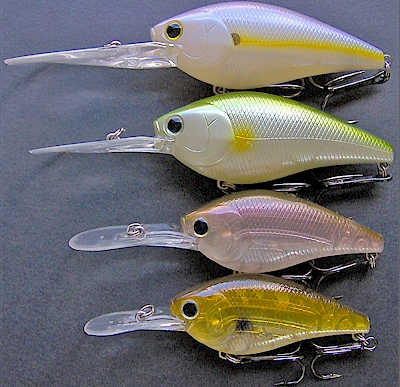
Top down: Flat CB D-20, D-12, DR and MR..
Lucky Craft Flat CB MR ~ Medium-Running Crankbait
Model: Flat CB MR
Type: Floating/Diving Crankbait
Weight: 3/8 oz (10.5g)
Length: 2-1/2" (63mm) excluding lip
Factory Hooks: Two #4 VMC Black Nickel
Depth: Approx. 4-5 feet
Shallow-running and medium-running baits are far more popular than deep-divers. There are simply more places and situations where shallow or medium-divers can be used compared to deep-runners. So it's no surprise that the Flat CB MR (Medium Runner) is by far the most popular model in the Flat CB series. The other Flat CB series models (DR, D12, D20) run deeper and are not as popular as the MR model.
I'd say the Flat CB MR works down around 5 feet more or less with 10 lb. test line, and can be used with 12 to 14 lb. test line, not getting quite as deep.
One of my favorite modifications with this lure is to replace the tail treble with a feathered one. I fancy the feathers enhance the movement and appearance of this particular bait. That's not the case with all crankbaits, but the Flat CB MR is one I routinely tag with a feather tail.
I like to use the Flat CB MR a lot like I use a lipless crank. It is stable and easy to crank at moderate to fast paces. Similar to a lipless crankbait, the Flat CB MR has a flat-sided body and a tight, fast wriggle. The advantage is in snaggy areas, the Flat CB MR is not prone to get stuck as easily as a lipless. So I often go to the Flat CB MR whenever fish are whacking lipless crankbaits in shallow or flooded brush or snaggy areas where the lipless gets snagged often. It's great to slam the Flat CB MR through shallow rocks and boulder beds too. These are places that lipless baits get snagged fairly easily - but the Flat CB MR with a similar action, does not get snagged as much or as badly. It's diving bill serves to bounce it off cover and shield the hooks from snags. If the Flat CB MR does get stuck, it's often the diving bill, not so much the hooks, that's jammed in a snag. So it can often be backed out of snags more easily than a lipless.
Bassdozer says: "The Flat CB MR and DR have nice, beefy hooks but are prone to tangle. You may want to experiment with shorter shank yet strong hooks that won't tangle that much."
Lucky Craft Flat CB DR ~ Deep-Running Crankbait
Model: Flat CB DR
Type: Floating/Diving Crankbait
Weight: 1/2 oz (11g)
Length: 2-1/2" (63mm) excluding lip
Factory Hooks: Two #4 VMC Black Nickel
Depth: Approx. 8-10 feet
The DR designation stands for Deep Runner. It works down around 10 feet with 10 lb test, and slightly less with 12 lb test.
The Flat CB DR is a money bait. I know of a number of tournaments won with the help of the Flat CB DR. Guys tend to use it in conjunction with the CB-350. Both these baits will get into the 8-10 foot range.
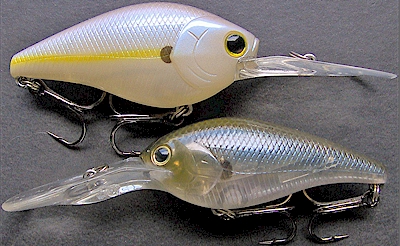
Flat CB DR (top) and CB-350 upgraded with Mustad #36300BLN X-strong, X-short size #4 trebles. This eliminates chronic tangling on the DR (and MR not shown) and is one size larger, yet won't tangle on the CB-350 (bottom).
One of the most productive places for these deep divers are the tire reefs, other barrier reefs, and floating breakwaters anchored around the perimeters of boat marinas to break the force of wind-driven waves. These man-made reefs and barriers make a safe harbor within the marinas, and they are also bass magnets at times. These types of floating bass cover tend to be out in open water, with little shade. In clear water, bass tend to suspend deeper under the floating breakwaters where depth equates to shade. These suspended bass are deeper than the average crankbait can reach them, but not so deep that a crankbait swimming in the 8-10 foot range can't entice them.
But deep diving crankbaits can be used in shallow water too. Many times I am bouncing, digging and rooting along the bottom in water as shallow as a few feet, even with these 8-10 foot divers. In fact, it is commonplace around ledges, bars and depth breaks to not get many hits while the crank is in deeper open water. Strikes rarely come until the deep diver gets up on the nearby shallow bar or ledge and starts stuttering across the gravel or digging in the sand. At that point, bass will materialize out of deep water, swimming onto the bar or ledge to pluck the bottom-gouging crankbait off the shallow bottom, often only a few feet deep.
At times I replace the tail treble on the Flat CB DR with a feathered one, but it's hardly necessary to do this.
Lucky Craft Flat CB D-12 ~ Deep-Diving Crankbait
Model: Flat CB D-12
Type: Floating/Diving Crankbait
Weight: 3/4 oz (22g)
Length: 3" (75mm) excluding lip
Factory Hooks: Two #2 VMC Black Nickel
Depth: Approx. 12 feet
True to its name, the D-12 gets down toward the 12 foot depth range more or less. It is a heavy duty crankbait that's larger and gets deeper than most other crankbaits anglers typically use - and it dredges up larger bass than most anglers typically catch as well. It's hard work to throw all day, but you can be well-rewarded by the D-12. You may not get as many, but they'll be heavy.
Bassdozer says: "One little thing to remember with the Flat CB's (MR, DR, D12, D20) is to give them all a yank before cranking. Internally they have a large metal ball that moves in a chamber to the back of the bait to help maximize casting distance. The ball does not always automatically roll back down the chamber behind the diving bill at the completion of a cast. So you may need to yank them first to help roll the ball down into the diving position before you crank. If you start cranking without first yanking, they'll struggle on the surface and won't dive deeply until the ball rolls out of the back."
Lucky Craft Flat CB D-20 ~ Super Deep-Diving Crankbait
Model: Flat CB D-20
Type: Floating/Diving Crankbait
Weight: 3/4 oz (23.5g)
Length: 3" (75mm) excluding lip
Factory Hooks: Two #2 VMC Black Nickel
Depth: Approx. 15-18 feet
There are only a few crankbaits that can get deeper than 15 feet (without trolling) and that handle well at that level. It's by far the rarest class of crankbaits, the super deep divers. So when Lucky Craft came out with the super deep D-20 some years ago, it was immediately deployed with good results by a savvy cadre of the sport's top national and top regional pro anglers. The pros who have been using these all along desire to keep it low, and a number of regional level tournaments have quietly been won over the years on it.
With a lot of recent focus on fishing deep cranks on the top national BASS and FLW Pro Tours, particularly in 2008, the D-20 has been getting a lot of play and much press recently from the Lucky Craft national pro staff anglers, so you should see the D-20 grow in popularity going forward.
The D-20's much larger and dives deeper than most anglers typically use. Indeed, it's about as extreme and heavy duty as a bass crankbait gets to be. There are few bigger crankbaits for bass (or that dive as deep), and those few that are this big, they are not as solidly-constructed as the D-20. It's heavy duty.
It's hard work to throw all day, but you can be well-rewarded by large bass landed on the super deep D-20. I'm super serious.
Lucky Craft Fat CB BDS-3 ~ Shallow-Diving Crankbait
Model: Fat CB BDS-3
Type: Floating/Shallow Diving Crankbait
Weight: 1/2 oz (14g)
Length: 3" (75mm) excluding lip
Factory Hooks: Two #2 VMC Black Nickel
Depth: Runs over/through emergent or submerged shallow cover, say 2-5 feet deep
The BDS-3 is the most popular size in the Fat CB BDS series. If you try just one BDS model, this is the one you want. The Fat CB BDS-3 is a relatively chunky, shallow-running, brawny bait with a wide wobble and rolling action. It has the perfect size, heft and hooks for brawling with bass in thick cover using relatively heavier line and cranking gear. It is buoyant and designed to perform somewhat like a balsa wood lure, except it is durable hard plastic construction that holds up to repeated, rugged use.
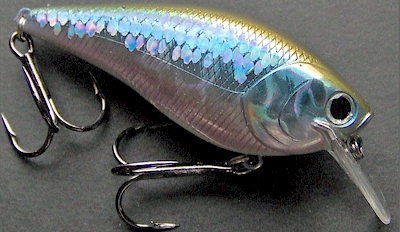
Heavy duty Fat CB BDS-3 is nearly indestructible.
Its lip design, hook positions and outstanding obstacle deflection qualities let the BDS-3 waltz right through the thickest of cover. It's ideal for fishing through laydowns, stump fields, docks, rocky shallow areas, tough-stalked weeds and other shallow thick cover. It doesn't rattle because the internal weighting is fixed-weight for quick deflection recovery. After the bait hits an object, it comes right back to proper position to continue the retrieve.
Lucky Craft LV Series ~ Lipless Crankbaits
The LV 200, 300 and 500 sound as if they should all be a common series of sizes of the same lure model. They're not. No two LV models are remotely related to each other. The LV 200, 300 and 500 are totally different lures. Each is designed quite differently and are best used for completely different techniques as described in the following sections.
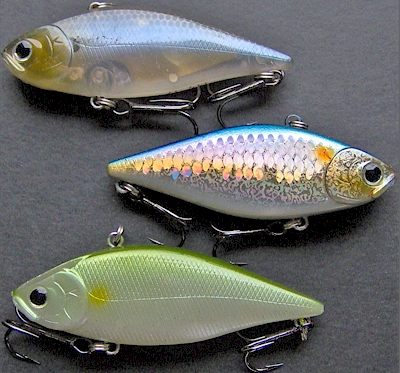
Top down: LV-200 single-knocker, LV-300 silent and LV-500 rattling models.
Lucky Craft LV-200 ~ Lipless Crankbait
Model: LV-200
Type: Sinking, Knocker
Weight: 5/8 oz (18g)
Length: 3" (72.5mm)
Factory Hooks: #4 Belly, #6 Tail VMC Black Nickel
Depth: Approx. 4 feet
Most all lipless cranks vibrate rapidly when retrieved, but not all rattle.
The LV-200 is one of the rare ones that doesn't rattle. It's known as a 'single knocker' type lipless bait. Instead of rattling, the LV-200 emits a steady tom-tom beat from a single heavy metal ball affixed to a loose metal plate inside. The LV-200 is a knocking type instead of a rattling type.
The LV200 emits a single-thump like a heartbeat as opposed to the incessant, raucous chatter of 'normal' rattling baits.
Lucky Craft LV-300 ~ Lipless Crankbait
Model: LV-300
Type: Sinking, Silent, Countdown
Weight: 3/4 oz (21.5g)
Length: 3" (69mm)
Factory Hooks: Two #6 VMC Black Nickel
Depth: Approx. 4 feet
As odd as it is for the LV-200 to contain only one ball to make it thump like a lonesome drum, the LV-300 has absolutely zero rattles inside.
The LV-300 vibrates like the dickens when retrieved, but doesn't have any noise-making parts inside.
The LV-300 is silent like Charlie Chan, the silent movie star of the thirties... but that's not bad.
Both these non-rattling lipless baits, the LV-200 thumper and silent LV-300 have helped me catch buckets of 'extra' bass whenever I use lipless lures. It's so simple yet deadly. I first go down a bank and pull the initial receptive fish with a 'normal' high-chattering bait such as the noisy LV-500 or LVR D-7. This initial noisiness 'wakes up' the bass so to speak. Once fish are exposed to fan-casting with high-chatterers, it can quickly become counterproductive to go back down the same bank again with the same high-chattering baits. The repeated noisiness (an attractant at first), can become a repellant that only serves to alienate fish by continuing to throw the very loud, harsh rattle baits. So what I do next is go down the same bank again with the quieter, single-thumping LV-200 or silent LV-300, often helping myself to catch another few good fish with this non-rattling approach the second time. It's a similar profile, similar vibration without the high-chatter. A few more fish always seem to fall for it.
The LV-200 and LV-300 are non-rattling lipless baits that perform well where you or other anglers have already peppered the bass with noisier lipless baits.
Either one can be the winning ticket when everyone and their uncle has been bombarding the bass with noisy rattling baits. If you're serious about lipless fishing, the LV-200 and LV-30 are must-haves.
Best of all, almost no one else uses them. The LV-200 and LV-300 are virtually unknown and unused Lucky Craft baits.
So if you're looking for a pair of secret lures that really do produce (especially when fish have been shown way too many of the noisier models), there you have them.
Another tactic I like with the LV-300, when bass are suspended or simply schooling over structure (points, channels, ledges, etc.), I'll tend to position the boat over a high spot or over the shallowest spot, and cast toward deeper, open water. Then simply let the LV-300 pendulum fall in an arc toward me.
The LV-300 is forward-weighted to run head down when retrieved, and this also helps it fall head down while sinking. It won't tailspin as it falls, and has a little more realistic and natural falling action than some other lipless cranks. It swaggers a little side to side as it falls forward toward you, head first. It tends to attract strikes (and can be worked with angler-imparted action) as it swaggers or glides side to side on the fall. You need to practice with it, and see what it does on different line sizes, with different slack or loose line pressure, discovering how best to make it pendulum head-first in a hunting, zigzag manner.
With suspended bass, the key is how far to let the LV-300 sink at first. When I let it get down to where I think the fish are, I'll give it one flip. This is an attention-getter. It signals something is not quite right. It's just like a shad in trouble that flips up on its side, making an attempt to right itself. I then let it fall again and give it two flips. Then let it pendulum fall in toward me again. All the while it is coming back to me in a pendulum arc, and give it three more flips. Just pop it quick, to give it a short, erratic, struggling movement. It moves at most one foot when you flip it. It's just an attention-getter that shows bass something is not right. I basically let the LV-300 swing back in to me, through the fish, above any cover, over any structure, and pop it once, twice or three times. On its way back in, as the bottom becomes shallower (remember to have the boat directly atop the high spot), it's advantageous if the crankbait bumps into brush or anything else as it arcs down closer to the bottom. That obstacle impact is a great strike trigger, and because it's falling nose first, its posture helps protect the hooks from snags. This may not seem like it would matter much, but the nose-down posture truly affords a lot of hook protection from snags. More often than not, the LV-300 will get nipped as it bounces off anything in its path. Once it reaches bottom, lift it up and let it swagger and sway on its way back down as you bring it in the rest of the way back to the boat.
Bassdozer says: "When time comes to replace the stock hooks on the LV-200, LV-300 and LV-500, upsize them all to two #4 trebles that won't tangle. Bigging up the hooks like this will not affect the action or how many strikes you get - and you'll hook, hold and land more fish."
Lucky Craft LV-500 ~ Lipless Crankbait
Model: LV-500
Type: Sinking, Rattling
Weight: 3/4 oz (23g)
Length: 3" (75mm)
Factory Hooks: #4 Belly, #6 Tail VMC Black Nickel
Depth: Approx. 8 feet
In comparison to the virtually unknown LV-200 and LV-300, the LV-500 is the number one choice of many anglers among all Lucky Craft's lipless baits.
The body size of the LV-500 matches that of most other 1/2 oz rattlebaits. However, the LV-500 is 3/4 oz so it casts longer distance and it descends much deeper than most others. This is the reason I rely on the LV-500 - it covers more distance much deeper than most any other rattlebait.
It isn't a good idea to let the LV-500 sink. When you cast, you must begin the retrieve immediately. If you wait to let the LV-500 settle deeper, it tends to tailspin and twirl around, snaring the fishing line in the hooks. So pay attention to how you use it. Don't give the LV-500 too much time to fall on a loose line.
Just burn it back! The LV-500 casts further and covers more water than other rattlebaits. On it's own, the LV-500 will seek a consistent running depth about 8 feet deep. You don't need to let it sink or count it down or anything. Just start winding it in, and next thing you know, it will seek its own running level around the 8 foot mark.
Depending on line type and line diameter, it will seek a working level of 7 to 10 feet deep all by itself. This is below where most other rattlebaits will stay on a retrieve. Best of all, you can burn the LV-500, and it will still stay that deep.
A favorite LV-500 tactic for me is to burn deep points. In lakes with lots of points, this can become an LV-500 pattern many days, where a bass or two will belt the LV-500 (usually retrieved fast) on practically every point. Once you uncover a pattern and it seems repeatable on a few points, then you can run from point to point to point, and repeatedly present the LV-500 the same way each time - and pull a good bass or two off each point. In this way, the LV-500 functions as a highly productive pattern bait - not just for points, but for whatever other repeatable pattern you can produce with the LV-500. Keep in mind, it is a deep runner, but you cannot count it down or pause it without frequently snarling the line.
When bass want that deeper running depth (which is often the case on bluffs or deep points), the LV-500's the best lipless crank in my bag! But it may be used for many different tactics too. More and more anglers are using it all the time, making the LV-500 one of the most popular lipless in Lucky Craft's line-up.
Lucky Craft LVR Series ~ Lipless Crankbaits
Lucky Craft's LVR models are a related series - essentially the same lure design in several different sizes. The middle sizes, the LVR D-7 and D-10 are the two I find most useful. The LVR Mini is a bit too light and the LVR D-15 a bit too big for everyday usage. But the LVR D-7 and D-10 are just right!
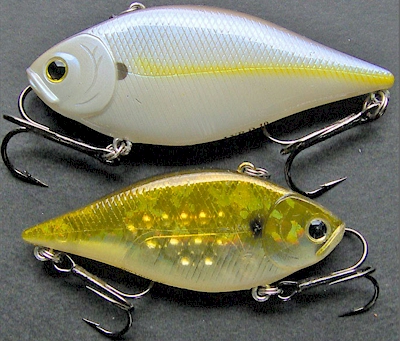
LVR D-10 (top) and LVR D-7.
Lucky Craft LVR D-7 ~ Lipless Crankbait
Model: LVR D-7
Type: Sinking, Rattling
Weight: 1/2 oz (14g)
Length: 2-3/4" (70mm)
Factory Hooks: Two #4 VMC Black Nickel
Depth: Approx. 3-5 feet
The D-7 is the most popular model in Lucky Craft's LVR series. If you were going to use just two Lucky Craft lipless models, the LVR D-7 and the LV-500 (in the LV series) would make the ideal duo.
The design of the LVR D-7 is thinner and to me, the LVR D-7 tends to ride higher with a little less vibration and less chatter than usual. I'm not saying it doesn't chatter a lot, but it is 'less loud' than other popular brands. It's most useful for me in shallow situations, when I want to keep a rattlebait high, or where I want to rattle through snaggy cover that grabs and snags other rattlebaits way too often, the LVR D-7 gets the nod.
Most all lipless cranks sink. However a D-7 may actually rise for the first few feet and first few seconds of a retrieve, even breaking the surface before it will start to hunker back down to its normal underwater running depth. You may wonder why this initial rise may be desirable? Good question. It's beneficial when fishing areas of submerged weed clumps, scattered underwater brush or irregular rock beds, stump fields and so on. A lipless crank that initially rises up and over snags at the start of a retrieve provides a presentation advantage when fishing snaggy cover. It gives you - and the lure - a chance to start clean and thereby gain control over the retrieve without immediately getting snagged in dense cover (as often happens) during the critical first few seconds.
Lucky Craft LVR D-10 ~ Lipless Crankbait
Model: LVR D-10
Type: Sinking, Rattling
Weight: 3/4 oz (23.5g)
Length: 3-1/8" (80mm)
Factory Hooks: Two #2 Belly VMC Black Nickel
Depth: Approx. 4-6 feet
The LVR D-10 has a bigger profile than most lipless baits. That's the simple reason I use it - to appeal to bigger bass. If you throw the LVR D-10 all day, you will bag a bigger average size of bass than if you threw standard size baits like the LVR D-7 or LV-500 in the same places. It's that simple.
Since the deep-bodied D-10 is built to be 'selective' for big bass, that makes it a good 'kicker fish' bait for tournaments. There are two schools of thought on this. First is to go for broke, fishing with the big D-10 right out of the starting gate. The second strategy is to fill out a limit of small fish with a standard size lipless, such as the D-7 or LV-500. Once you've gotten to the stage where all you're doing is culling clones without really upgrading your weight, then switch to the bigger profile D-10 to go for that necessary kicker. Whatever strategy you use, a bigger lipless like the D-10 does bag bigger bass than average.
Bassdozer says: "I like to hang feathered trebles off the back of the LVR D-7 and the LV-200. I feel feathers enhance the everyday action and appearance of those two lipless models in particular. When you add feathers, you'll find that fish will tend to strike directly at the feathers - or engulf the lure from behind, feathers first. This contradicts a popular strike theory that says fish nip or bite at the tail of a hard bait because the bait is the wrong color, wrong size or wrong something. According to this theory, fish striking at the tail aren't overly-enthused with the lure, and the tail bites are supposed to signal to or alert the angler to toss them a better color or different bait than this bogus one. This theory is not true - at least not with feathered tails. Fish strike the feathered back hook because they like it, because that's where the action is. Many days when weak and missed strikes occur, adding a feathered tail will result in solid or engulfing strikes - at the back feathers or from behind. Bass can become more interested and excited to strike the feather tail than the lure itself."
Lucky Craft Crankbait Color Considerations
Lucky Craft is legendary for it's artful, natural baitfish colors. Where Lucky Craft lures excel, what they do better than many other vendors, are complex yet natural finishes. Lucky Craft colors tend to be muted, diffused, subtle, softer colors that blend into each other and blend into the underwater environment.
They're not known for their bright chartreuse-based, fire tiger or other bold color patterns. You won't see a lot of red throat splashes, red eyes or other gaudy lipstick either. Although adding your own red replacement hooks may make a nice accent at times.
The four most popular colors across most every Lucky Craft product model are:
Chartreuse Shad #250 is said to be 'the' most popular Lucky Craft color. If you had to limit yourself to just one color, Chartreuse Shad is it.
Ghost Minnow #238 is considered the most popular clear water color currently in the Lucky Craft line-up.
Aurora Black #052 is flashy, yes, but not nearly so flashy as MS American Shad. Aurora Black is much more subdued and subtle.
MS American Shad #270 is one of Lucky Craft's (or any other vendor's) most beautiful colors. The 'MS' means 'Magic Scales'. It is a high flash color for when fish want a lot of flash in a lure. Yet it is still natural. It is truly a special experience to fish with it.
MS Herring #254 is another of the most beautiful of all Lucky Craft colors. It is similar to MS American Shad in that they are both high flash colors. However, MS Herring does not come in every crankbait model.
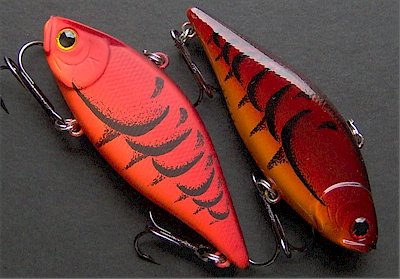
Mad Craw #286 (left) and Spring Craw #070 (right) are quite popular colors for lipped crankbaits and lipless.
~ End of part 1 (of 3) ~
Visit www.bassdozer.com and www.bassdozerstore.com for more information. Thank you and good luck fishing!



No comments:
Post a Comment